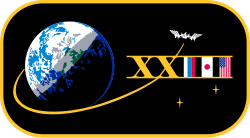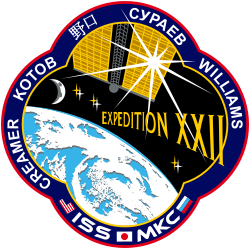Oleg Kotov
| Oleg Kotov (Олег Котов) | |
 Oleg Kotov | |
| Kosmonaut | |
|---|---|
| Tillstånd | Aktiv |
| Född | 27 oktober 1965 Simferopol, |
| Andra yrken | Läkare |
| Grad | Överstelöjtnant |
| Tid i rymden | 526 dgr 5 tim 4 min |
| Urvalsgrupp | 1996 RKA |
| Antal rymdpromenader | 6 st |
| Rymdpromenadtid | 36 tim 51 min |
| Uppdrag | Sojuz TMA-10 Expedition 15 Sojuz TMA-17 Expedition 22 Expedition 23 Sojuz TMA-10M Expedition 37 Expedition 38 |
| Uppdragsemblem | |
| Utmärkelser | |
Oleg Kotov (ryska: Олег Котов), född den 27 oktober 1965 i Simferopol, Ukrainska SSR, Sovjetunionen, är en rysk kosmonaut.
Tillsammans med landsmannen Fjodor Jurtjichin och rymdturisten Charles Simonyi sköts Kotov upp i rymden från Kazakstan den 7 april 2007. Han tillhörde under sin vistelse på rymdstationen ISS Expedition 15.
Rymdfärder
Externa länkar
 Wikimedia Commons har media som rör Oleg Kotov.
Wikimedia Commons har media som rör Oleg Kotov.
Media som används på denna webbplats
The focal point of the Expedition XXIII emblem illustrates the beautiful planet Earth in the black expanse of space. The International Space Station (ISS) is shown traveling in its orbit around Earth. The ISS orbital path flies through the XXIII to show that this increment is building upon the missions that have gone on before and laying the groundwork for future missions. This illustrates the work being performed aboard the orbiting complex that will lead the way to eventual missions to the moon, Mars and beyond. The mission designation uses Roman numerals to illustrate the home nations of the crew, which are also represented by their national flags. The two stars represent the two teams that make up this expedition crew.
JSC2006-E-50531 (21 Sept. 2006) --- Cosmonaut Oleg V. Kotov, flight engineer representing Russia's Federal Space Agency
ISS Expedition 38 Patch
As the International Space Station (ISS) has become a stepping stone to future space exploration, the Expedition 38 mission patch design paints a visual roadmap of exploration beyond low Earth orbit, most prominently represented by the design's flowing Expedition 38 mission numbers that wrap around Earth, the moon and Mars. Just as the sun is a guiding light in the galaxy, the ISS illuminates the bottom of the design as it is a shining beacon of the advancement of science, knowledge, and technology carried out aboard the Space Station. To visually capture the idea of the ISS being a foundation for infinite discovery, the space station's iconic solar arrays span upwards, providing the number 38 and its exploration roadmap a symbolic pedestal to rest on. Finally, the overall use of red, white, and blue in the design acknowledges the flags of the countries of origin for Expedition 38's crew -- the United States, Russia, and Japan.
The operational teamwork between human space flight controllers and the on-orbit crew take center stage in this emblem. Against a backdrop familiar to all flight controllers, past and present, independent of any nationality, the fifteenth expedition to the ISS is represented in Roman numeral form as part of the ground track traces emblazoned on the Mercator projection of the home planet Earth. The ISS, shown in its fully operational, assembly complete configuration, unfurls and then reunites the flags of this Russian and American crew in a show of our continuing international cooperation. Golden spheres placed strategically on the ground track near the flight control centers of the United States and Russia serve to symbolize both the joint efforts from each nation's team of flight controllers and the shuttle and Soyuz crew vehicles in their chase orbit as they rendezvous with the ISS. A rising sun provides a classic touch to the emblem signifying the perpetual nature of manned space flight operations and their origin in these two space-faring nations.
Hero of the Russian Federation gold medal.
Leonardo da Vinci's Vitruvian Man, created some 525 years ago, as a blend of art and science and a symbol of the medical profession, is depicted amongst the orbits of a variety of satellites circling the Earth at great speed. Da Vinci's drawing, based on the proportions of man as described by the Roman architect Vitruvius, is often used as a symbol of symmetry of the human body and the universe as a whole. Almost perfect in symmetry as well, the International Space Station, with its solar wings spread out and illuminated by the first rays of dawn, is pictured as a mighty beacon arcing upwards across our night skies, the ultimate symbol of science and technology of our age. Six stars represent the six members of Expedition 37 crew, which includes two cosmonauts with a medical background, as well as a native of Da Vinci's Italy.
The 22nd Expedition to the International Space Station is dedicated to the final stages of assembly and the transition to full utilization as an orbiting laboratory. The sun, providing power and life support to the space station, shines through one of the solar arrays as the ISS orbits above Earth. The oceans and atmosphere, providing life support to Earth, are shown in all their beauty. The moon hovers in the distance as the goal of the next era of exploration. The six stars illustrate the increased capability of the crew complement. In the border are the national flags of the crew members as well as their surnames in their native languages. Expedition XXII continues the effort to acquire the knowledge necessary to extend the reach of exploration from Earth, to the moon and beyond.







